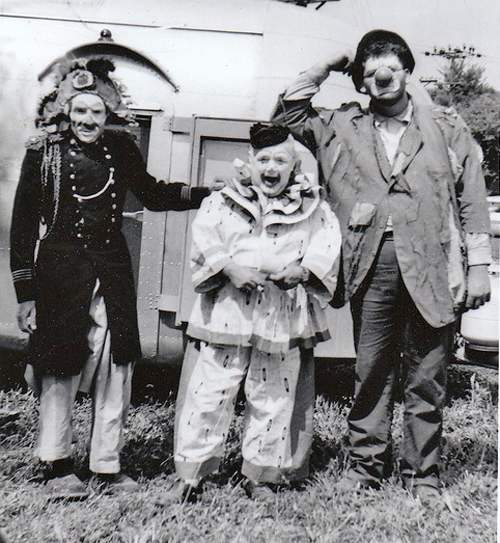 |
Clowns are the pegs on which the circus is hung.
—P.T. Barnum
A clown is a poet in action.
—Henry Miller
|
Clowns have a proud history as buffoons with dignity and grace.
 Commedia dell'arte in Italy was performed from the 16th to the 18th century. Harlequins traveled to France, where they stopped speaking. (In England they evolved into Punch and Judy puppet shows: not so much grace.) Commedia dell'arte in Italy was performed from the 16th to the 18th century. Harlequins traveled to France, where they stopped speaking. (In England they evolved into Punch and Judy puppet shows: not so much grace.)
 Early 19th century circus clowns were accessories to horse acts, mocking the riders. Early 19th century circus clowns were accessories to horse acts, mocking the riders.
 In the late 19th century there were 30 professional clowns in Paris and London. They were highly respected, not just fools. They had extended acts called "entreés." These skits made fun of the highfalutin’, but the characters were easy to identify with. Laughing at their anxieties and vulnerabilities helped people feel better. In the late 19th century there were 30 professional clowns in Paris and London. They were highly respected, not just fools. They had extended acts called "entreés." These skits made fun of the highfalutin’, but the characters were easy to identify with. Laughing at their anxieties and vulnerabilities helped people feel better.
|
Traditionally, there were three kinds of clowns.
 |
 |
 |
| Whiteface clowns came from the tradition of Pierrot in commedia dell'arte. They were elegant, optimistic, straight men to the Augustes. They wore ruffled neckpieces. They kept trying to do good things. |
Auguste clowns were bums, sad sacks that messed up the plans of whitefaces. They wore baggy clothes and big shoes. They were resigned to their fates.
|
Grotesques were every other kind of clown role, like babies and fat ladies. |
Tom Belig was an equestrian in Germany who, legend has it, showed up late for one show. He was drunk and a bit disheveled, and kept falling off his horse. The audience loved it, calling out "auguste!" which means idiot. He showed up the next night in baggy pants and a wig, with a brick dust red nose and soot on his face. A clown was born, and a new kind of clown imitated him.
|

Buster Keaton, Charlie Chaplin, and Emmett Kelly were Augustes. |
 Circus clowns are physical performers. Circus clowns are physical performers.
Clown mayhem includes slapstick: they're tumblers, acrobats, and jugglers. They stand (and fall) in contrast to the slick, serious performers. When circuses got too large for clowns' voices to be heard, clowns had to learn to do everything in pantomime. They had to amuse very diverse audiences, and some of the bleachers were pretty far away.
Clowns continued to talk in small circuses (some cackler clowns were quite risqué). Of course, sound systems later made it possible for clowns to have a voice.
Clown make-up is also designed to communicate emotions to huge crowds.
Clowns and dancers distract the crowd while cages and equipment are changed. They also do acts in side rings: clowns and dancing girls are the performers who work hardest.
|
Clowns are beloved by artists.
In the 19th and early 20th century artists didn't depict clowns as fools, but with "fragile and transcendent joy; not glee but pathos."
Artists, including Daumier, Toulouse-Lautrec, and Picasso, identified with clowns. Georges Rouault depicted clowns as Christ-like figures, betrayed and sacrificed.
American artists who depicted clowns included John Sloan, e.e. cummings, Edward Hopper (Soir Bleu 1914), and Henry Miller.

Rouault |

Picasso |

Renoir |

Sloan |
 Hopper Hopper |
 Chagall Chagall |

Toulouse-Lautrec |
|
|
   |
|
one winter afternoon
—e.e. cummings
one winter afternoon
(at the magical hour
when is becomes if)
a bespangled clown
standing on eighth street
handed me a flower.
Nobody, it’s safe
to say, observed him but
myself; and why? because
without any doubt he was
whatever(first and last)
most people fear most:
a mystery for which i’ve
no word except alive
–that is, completely alert
and miraculously whole;
with not merely a mind and a heart
but unquestionably a soul–
by no means funereally hilarious
(or otherwise democratic)
but essentially poetic
or ethereally serious:
a fine not a coarse clown
(no mob, but a person)
and while never saying a word
who was anything but dumb;
since the silence of him
self sang like a bird.
Most people have been heard
screaming for international
measures that render hell rational
– i thank heaven somebody’s crazy
enough to give me a daisy |
  |
|
 |
|
  |
|
|
|
|
|

|


